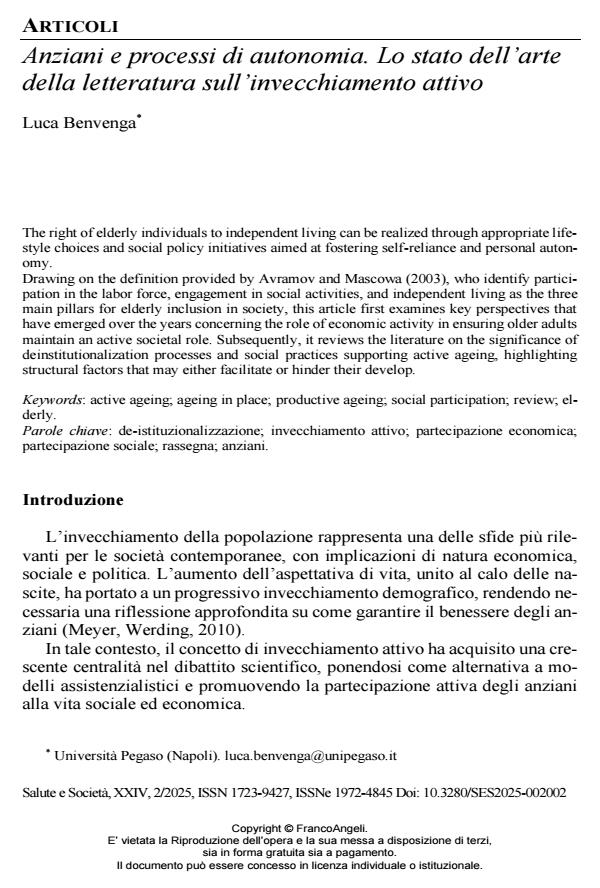Anziani e processi di autonomia. Lo stato dell’arte della letteratura sull’invecchiamento attivo
Titolo Rivista SALUTE E SOCIETÀ
Autori/Curatori Luca Benvenga
Anno di pubblicazione 2025 Fascicolo 2025/2
Lingua Italiano Numero pagine 11 P. 9-19 Dimensione file 328 KB
DOI 10.3280/SES2025-002002
Il DOI è il codice a barre della proprietà intellettuale: per saperne di più
clicca qui
Qui sotto puoi vedere in anteprima la prima pagina di questo articolo.
Se questo articolo ti interessa, lo puoi acquistare (e scaricare in formato pdf) seguendo le facili indicazioni per acquistare il download credit. Acquista Download Credits per scaricare questo Articolo in formato PDF

FrancoAngeli è membro della Publishers International Linking Association, Inc (PILA)associazione indipendente e non profit per facilitare (attraverso i servizi tecnologici implementati da CrossRef.org) l’accesso degli studiosi ai contenuti digitali nelle pubblicazioni professionali e scientifiche
The right of elderly individuals to independent living can be realized through appropriate lifestyle choices and social policy initiatives aimed at fostering self-reliance and personal autonomy. Drawing on the definition provided by Avramov and Mascowa (2003), who identify participation in the labor force, engagement in social activities, and independent living as the three main pillars for elderly inclusion in society, this article first examines key perspectives that have emerged over the years concerning the role of economic activity in ensuring older adults maintain an active societal role. Subsequently, it reviews the literature on the significance of deinstitutionalization processes and social practices supporting active ageing, highlighting structural factors that may either facilitate or hinder their develop.
Parole chiave:Keywords: active ageing; ageing in place; productive ageing; social participation; review; elderly. de-istituzionalizzazione; invecchiamento attivo; partecipazione economica; partecipazione sociale; rassegna; anziani.
- Meyer V., Werding M. (2010). Ageing and the welfare state: securing sustainability. Oxford Review of Economic Policy, 26: 655-673.
- Adams K.B., Leibbrandt S., Moon H. (2011). A critical review of the literature on social and leisure activity and wellbeing in later life. Ageing & Society, 31(4), 683–712. DOI: 10.1017/S0144686X1000109
- Avramov D., Maskova M. (2003). Active Ageing in Europe. Population studies. Strasbourg: Council of Europe Publishing.
- Barbabella F., et al. (2011). Volontariato in età matura: opportunità, barriere e best practices per il coinvolgimento degli anziani. Quaderni europei sul nuovo welfare, 16.
- Bernardini M.G. (2023). Anziani e diritto all’abitare: Bisogni, diritti e prospettive tra locale e universale. Milano: FrancoAngeli.
- Biddle S. (2016). Physical activity and mental health: evidence is growing. World Psychiatry, 15:176-7.
- Boudiny K. (2013). ‘Active ageing’: from empty rhetoric to effective policy tool. Ageing & Society, 33(6), 1077-1098. DOI: 10.1017/S0144686X1200030
- Butler R.N., Gleason H.P. (1985). Productive aging: Enhancing vitality in later life. New York: Springer.
- Cumming E., Henry W.E. (1961). Growing Old: The Process of Disengagement. New York: Basic Books.
- Deluigi R. (2008). Divenire anziani, anziani in divenire. Prospettive pedagogiche fra costruzione di senso e promozione di azioni sociali concertate. Roma: Aracne.
- De Rosa E., Tibaldi M. (2015). Partecipazione al lavoro, invecchiamento attivo e transizione verso la pensione della popolazione over 50, Osservatorio Isfol, 1: 65-68.
- Díaz-López M.D.P., et al. (2016). Keys to active ageing: new communication technologies and lifelong learning. SpringerPlus, 5, 1-8.
- Douglas H., Georgiou A., Westbrook J. (2017). Social participation as an indicator of successful aging: an overview of concepts and their associations with health. Australian Health Review, 41: 455-462. DOI: 10.1071/AH16038
- Ferreira O.G.L., et al. (2012). Active aging and its relationship to functional independence. Texto & Contexto-Enfermagem, 21, 513-518.
- Garavaglia E., Marcaletti F. (2012). Invecchiamento attivo e solidarietà tra generazioni: una sfida per il futuro del lavoro. Milano: FrancoAngeli.
- Gronek P., et al. (2020). A review of exercise as medicine in cardiovascular disease: Pathology and mechanism. Aging and Disease, 11(2), 327-340. DOI: 10.14336/AD.2019.051
- Havighurst R.J. (1961). Successful Ageing. The Gerontologist, 1: 8-13.
- Horner B., Boldy D.P. (2008). The benefit and burden of “ageing-in-place” in an aged care community. Australian Health Review, 32(2), 356-365. DOI: 10.1071/AH08035
- Kalirajan K.P., Shantakumar G. (1998). Ageing labour force in a labour shortage economy: the case of Singapore. International Journal of Social Economics, 25(2/3/4), 486-500. DOI: 10.1108/0306829981019370
- Kingston P., et al. (2001). Assessing the Health Impact of Ageing-in-Place Policies: A Review of the Evidence. London: Health Development Agency.
- Lakomy M. (2021). Differences in social participation of older adults across European welfare regimes: Fourteen years of SHARE data collection. International Sociology, 36(6), 906-925. DOI: 10.1177/0268580921993
- Luppa M., et al. (2010). Prediction of institutionalization in the elderly. A systematic review. Age and Ageing, 39(1), 31-38.
- Malanowski N., Ozcivelek R., Cabrera M. (2008). Active ageing and independent living services: the role of information and communication technology. European Community, 39.
- Mayence S., Deconinck W., Lorent R. (1977). Un 3e âge actif. Bruxelles: Editions Labo.
- Morrow-Howell N., et al. (2003). Effects of volunteering on the well-being of older adults. The Journals of Gerontology Series B: Psychological Sciences and Social Sciences, 58(3), S137-S145.
- Rudawska I. (2010). Active ageing and its impact on labour market. Economics & Sociology, 3(1): 9. DOI: 10.14254/2071-789X.2010/3-1/
- Sarlo A., Costa G., Quattrini S. (2024). Invecchiare a casa propria: Servizi e pratiche innovative per l’ageing in place. Università Mediterranea di Reggio Calabria.
- Sixsmith A., et al. (2014). Ageing and innovation in Europe: Addressing the needs of the ageing population. European Journal of Ageing, 11(3): 223-232.
- Tarantino C. (2024). Il soggiorno obbligato. Bologna: il Mulino
- Togni F., Boffo V. (2024). Promoting Active Longevity: The Challenge of Continuing Education for Well-being, Beyond and Above the Emergency. Form@re - Open Journal Per La Formazione in Rete, 24:149–160.
Luca Benvenga, Anziani e processi di autonomia. Lo stato dell’arte della letteratura sull’invecchiamento attivo in "SALUTE E SOCIETÀ" 2/2025, pp 9-19, DOI: 10.3280/SES2025-002002